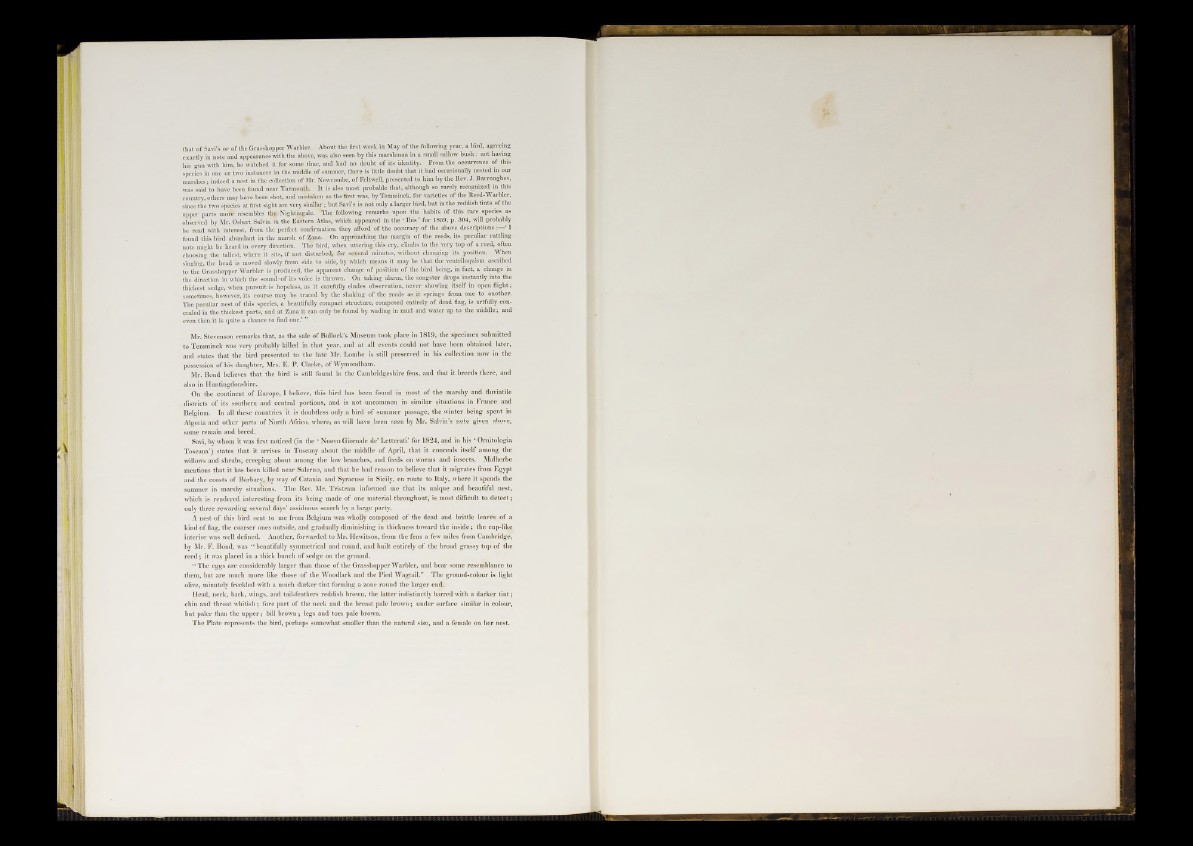
that of Savi’s or of the Grasshopper Warbler. About thé first week in May of the following year, a bird, agreeing
exactly in note and appearance with the above, was also seen by this marshman in a small sallow bush : not having
his gun with him, he watched it for some time, and had no doubt of its identity. From the occurrence of this
species in one or two instances in the middle of summer, there is little doubt that it had occasionally nested in our
marshes ; indeed a nest in the collection of Mr. Newcombe, of Felt well, presented to him by the Rev. J. Burroughes,
was said’to have been found near Yarmouth. It is also most probable that, although so rarely recognized in'this
country, others may have been shot, and mistaken as the first was, by Temminck, for varieties of the Reed-Warbler,
since the two species at first sight are very similar ; but Savi's is not only a larger bird, but in the reddish tints of the
upper parts more resembles the Nightingale. ’The following remarks upon the habits of this rare species as
observed by Mr. Osbert Salvin in the Eastern Atlas, which appeared in the ‘ Ibis’ for 1859, p. 304, will probably
be read with interest, from the perfect confirmation they afford of the accuracy of the above descriptions ‘ I
found this bird abundant in the marsh of Zana. On approaching the margin of the reeds, its peculiar rattling
note might be heard in every direction. The bird, when uttering this cry, climbs to the very top of a reed, often
choosing the tallest, where it sits, if not disturbed, for several minutes, without changing its position. When
singing, the head is moved slowly from side to side, by which means it may be that the ventriloquism ascribed
to the Grasshopper Warbler is produced, the apparent change of position of the bird being, in fact, a change in
the direction in which the sound-of its voice is thrown. On taking alarm, the songster drops instantly into the
thickest sedge, when pursuit is hopeless, as it carefully eludes observation, never showing itself in open flight ;
sometimes, however, its course may be traced by the shaking of the reeds as it springs from one to another.
The peculiar nest of this species, a beautifully compact structure, composed entirely of dead flag, is artfully concealed
in the thickest parts, and at Zana it can only be found by wading in mud and water up to the middle; and
even then it is quite a chance to find one.’ ’’
Mr. Stevenson remarks that, as the sale of Bullock’s Museum took place in 1819, the specimen submitted
to Temminck was very probably killed in that year, and at all events could uot have been obtained later,
and states that the bird presented to the late Mr. Lombe is still preserved in his collection now in the
possession of his daughter, Mrs. E. P. Clarke, of Wymondham.
Mr. Bond believes that the bird is still found in the Cambridgeshire fens, and that it breeds there, and
also in Huntingdonshire.
On the continent of Europe, I believe, this bird has been found in most of the marshy and fluviatile
districts of its southern and central portions, and is not uncommon in similar situations in France and
Belgium. In all these countries it is doubtless only a bird of summer passage, the winter being spent in
Algeria and other parts of North Africa, where, as will have been seen by Mr. Salvin’s note given above,
some remain and breed.
Savi, by whom it was first noticed (in the ‘ Nuovo Giomale de’ Letterati’ for 1824, and in his ‘ Ornitologia
Toscana’) states that it arrives in Tuscany about the middle of April, that it conceals itself among the
willows and shrubs, creeping about among the low branches, and feeds on worms and insects. Malherbe
mentions that it has been killed near Salerno, and that he had reason to believe that it migrates from Egypt
and the coasts of Barbary, by way of Catania and Syracuse in Sicily, en route to Italy, where it spends the
summer in marshy situations. The Rev. Mr. Tristram informed me that its unique and beautiful nest,
which is rendered interesting from its being made of one material throughout, is most difficult to detect ;
only three rewarding several days’ assiduous search by a large party.
A nest of this bird sent to me from Belgium was wholly composed of the dead and brittle leaves of a
kind of flag, the coarser ones outside, and gradually diminishing in thickness toward the inside ; the cup-like
interior was well defined. Another, forwarded to Mr. Hewitson, from the fens a few miles from Cambridge,
by Mr. F. Bond, was “ beautifully symmetrical and round, and built entirely of the broad grassy top of the
reed ; it was placed in a thick bunch of sedge on the ground.
“ The eggs are considerably larger than those of the Grasshopper Warbler, and bear some resemblance to
them, but are much more like those of the Woodlark and the Pied Wagtail.” The ground-colour is light
olive, minutely freckled with a much darker tint forming a zone round the larger end.
Head, neck, back, wings, and tail-feathers reddish brown, the latter indistinctly barred with a darker tint ;
chin and throat whitish ; fore part of the neck and the breast pale brown ; under surface similar in colour,
but paler than the upper ; bill brown ; legs and toes pale brown.
The Plate represents the bird, perhaps somewhat smaller than the natural size, and a female on her nest.